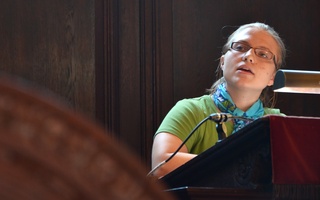Acclaimed novelist Donna Tartt spoke at the Brattle Theatre on Thursday as part of the Harvard Book Store’s ongoing series of writer lecture events. She first read an excerpt from her latest work “The Goldfinch,” released on October 22, and then answered questions from the audience, dwelling particularly on her own writing process and its results not only in the new book, but also in her prior work.
“The Goldfinch” is the story of a boy, Theo Decker, whose mother is killed in a terrorist attack, and the excerpt that Tartt read was from that period immediately following the death of Theo’s mother. In the rich diction and visual detail that is typical of Tartt’s work, she describes his time at the apartment of his overachieving high school friend Andy.
Upon finishing her reading, Tartt first fielded a question about what authors influenced her most in her own approach. “I picked up different things from different authors over the years,” she said. While she cited the influence of Dickens and Nabokov, she particularly dwelt on that of Robert Louis Stevenson. “Stevenson is a wonderful stylist, but he’s also capable of a terrifying psychological realism,” she said.
She later returned to the topic of her own way of writing when one audience member asked, “Why do you take so long?” in reference to the fact that she has published three novels in two decades. Her answer, delivered to the laughter of the audience, was very simple. “Because that’s the way I enjoy doing it,” she said. “My Greek teacher used to say, if you’re not enjoying it, you’re probably doing it too fast.” She discussed how writing a novel slowly gives her time to get to know the characters well before discarding them, and further, allow her to add to the richness of detail for which she is so well known. “I’m really a miniaturist at heart,” she said.
Tartt is probably best known for her first novel “The Secret History,” which chronicles the murderous travails of a small, elite group of classics students at a New England liberal arts college. She mentioned obliquely the difficulty of killing characters: “There was a sad day’s work I had to do while writing ‘The Secret History,’” she said. When asked if the characters from this work, as well as her others, still lived with her, she responded emphatically, “Oh, yes, yes. They do."
Read more in Arts
7 Things That Felt Longer Than the Past Two MonthsRecommended Articles
-
Notion of Success DebatedThree speakers—each with ties to business or religion—discussed different perspectives on how to define personal success.
-
Business School Publishing Arm RestructuresHarvard Business School’s publishing arm has recently restructured itself to streamline the editorial process in response to the changing nature of the publishing industry.
-
 Famous People and Their Theses
Famous People and Their Theses -
To Talk About an InjusticeMy belief that murderers deserve to die didn’t mean I had to support the death penalty. In fact, if I was committed to the American principles of liberty, responsibility, due process, and justice, I should vehemently oppose it.
-
Student Writes Book To Capture Professor's WisdomEric C. Sinoway was startled by the possibility of losing a close friend and mentor. Sinoway began to record some of the lessons Stevenson had taught him and ultimately published a book in October 2012.
-
 For Some Students, University Quiet on 9/11
For Some Students, University Quiet on 9/11













